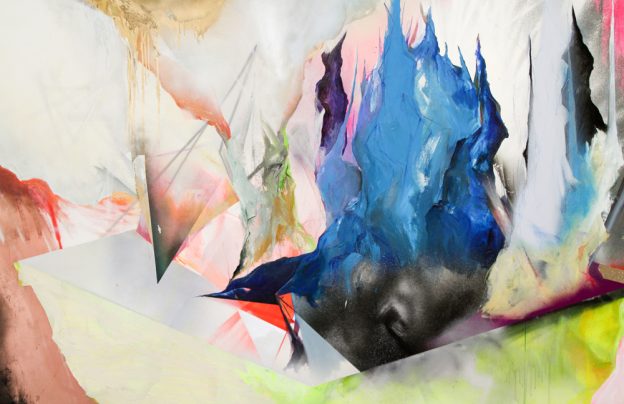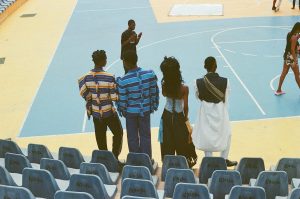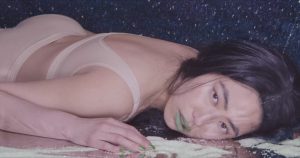with KINGDOM OF THE DISPOSSESSED
an artwork by SADIE WEIS
One quality of something irresistible is that it outlives your attention. The more it fades into layers of time, or the more one becomes necessarily distant from that thing, the more that thing preserves its captivating power. Perhaps, only if paid attention to, does that thing come back into existence. Yet, even attention, with its cravings and false results, would be too direct of an act—for the slow burning of an irresistible thing—to prove its irrefutable and continued existence. Rather, it’s through sheer reencounter that, lodged as they ever are in our minds and bodies in the form of an encrusted notion, or a shapeless dent, objects lash out at us, or embrace us, intensely.
The pale, lukewarm features of something irresistible live on, and even if we scramble to pull ourselves out of their elusive grip, we might be better off because of them. They anchor our wayward movements, and serve as a compass to our seemingly aimless pursuits.
The narrator of the short story Exile is in too close a proximity with such irresistible things. As he breathes on, he keeps squeezing his being in and out of time slots and spaces that are both real and imaginary. Fantastical even, as people and objects in the story become again—because elsewhere in his life they were—those irresistible things for the narrator. And just as it seems as if their presence is real—friends, fathers, writers, streets—they flicker into creature-like forms, endowed with some decisive identity whose language in turn weighs on the narrator.
On the one hand, they reside in the narrator’s lived reality. On the other, to dispel the sporadic unreality of these presences, of their enunciations, means for the narrator to dispel their own reality. It’s a bind, and it’s bursting quietly somewhere in the story.
Only in surrendering to the haunting quality of what one is irresistibly drawn to can one emerge equipped with an ability to resist it.
The visual work accompanying the short story Exile is a series of photographs documenting an artwork by artist Petrit Halilaj. Almost literally a proof of an irresistible thing, in this work he transported a piece of home/land from his birthplace, in Kosovo, to an art fair in Basel, Switzerland. Excavated with all its living, dead, and spectral creature-like forms and presences, he made multiple statements at once, including on exile and migration.
When I first met artist Petrit Halilaj in a bar, in the fall of 2010 in Berlin, his restlessness tried to hide behind a thick winter coat. He was still buzzing from the transformative effect his last work had had on him, and certainly on many who had seen it. This other work was an art installation at Berlin Biennale, a renowned contemporary art event, that had just taken place earlier that summer. I never saw it myself, having just arrived in town in October, but I instantly ‘saw’ it, nonetheless, seeing Petrit in person.
At some point after the ravaging war, his native family in Kosovo began constructing a new house—a home he had already grown away from, and had also become a fostered son of an Italian family that had lifted him, at the age of 12, from a refugee camp into safety. Having come of age in between multiple disaster scenarios (war, adolescence, identity) he created out of the pervasive helplessness of these scenarios irresistible works of art. Thus for his work of Berlin Biennale he recreated the framework of the house his family rebuilt right after the war. . . An absence, a separation, a haunting. A marking for life. An irresistible pull. Moreover, a recruitment of everything and everyone in the service of bracing that pull. Then, surrender. He titled it: The places I’m looking for, my dear, are utopian places, they are boring and I don’t know how to make them real.
Both the replica of the house, and the excavated/transported ground, among other works, can be seen as variations on themes such as exile and dispossession. Also, of missed and scored encounters across crucial moments in life when it becomes self-evident that reality is not only stranger (adolescence) and more sinister (war) than fiction (identity), but that creative expression is the only way, if not out, then of remaining sane within reality.
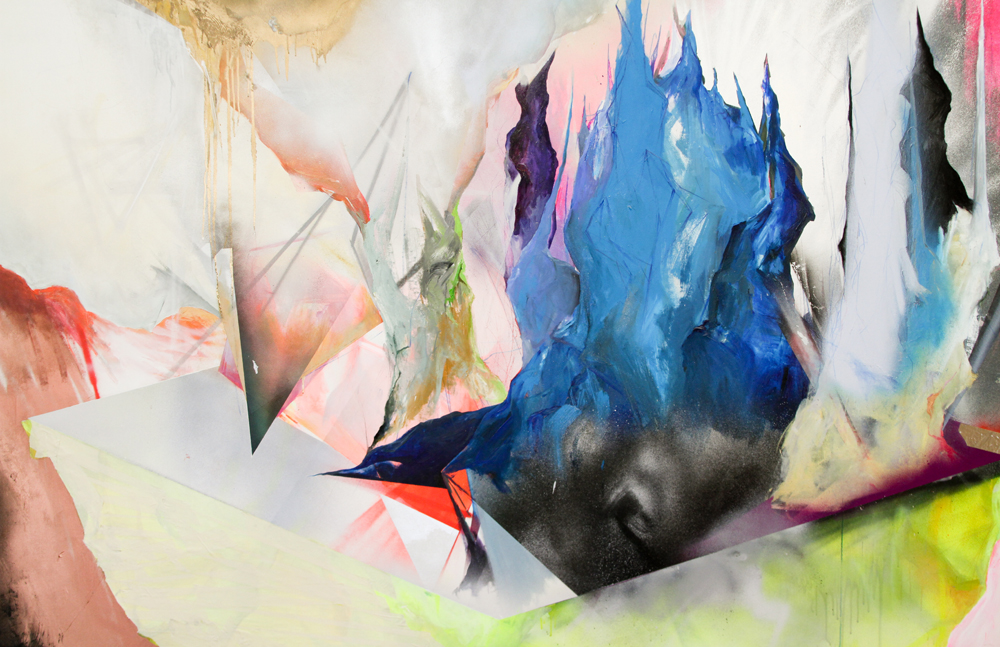
It was not long since I had arrived in Berlin, a few months in indeed, and it’s at the same bar where I first met artist Sadie Weis, whose delicate work of teleporting beauty is featured here, as well as in our Fallow issue. Sadie worked in the bar, and had herself just arrived from Kansas in pursuit of her own irresistible flash. She struck me from the first encounter as a being in thrall to Being. It seemed to me as if this person, this artist, this sensibility, was in contact, if not with something beyond, then certainly engrossed in a beautiful, private, outside. Nothing she exuded was immediately perceivable as conventional. I called her “shiney”.
It must have been the way I was in touch with the urges in my own life, those that I resisted, those that I escaped, and most importantly, those that I was, from then on, in fervent pursuit of, that led to instant friendships with both Petrit and Sadie. Already in the first exchanges, the fleeting, incandescent scenarios that had made up their lives, began to show in the form of stories about their exiled pursuits.
This was the very beginning of the last decade, where the word instant still had the ring of an assiduous sense of contact, almost transformation upon first touch. In contrast to today’s contagion of digital instantaneousness, with its viral effects, the experience of firsthand encounter has a long-drawn sense of yearning built in. While there’s hardly any proof of the former’s raison d’être, the latter seems to follow what appears to be a predestination. Havok, the character in the story Exile, as cast adrift as he may seem, is able to move forward only thanks to such instances of firsthand, non-digital, contact. He seeks it, in the unlikeliest of places: rummaging through emails, playing back in his mind remembered conversations, and giving in to irresistible free associations.
These two friendships, the way they were struck, in time, are evidence, if only personal, of that now-lost sense of instantaneous, long-lasting impact encounters among people can have. Instantaneous upload and download, if you will, of one’s being into another’s, in the form of countless conversations and days spent together, of tireless mutual sharings in the time-space continuum, of being physically alive together, and in thrall to life.
Beleaguered, downtrodden, poor, and exiled, too.
We had erred. We had misfired. We had left other places and lives, which had sometimes left us in turn. Yet we met, in this bar, this city, and in other manifestations of here. The first semblances of full-bloodied return appeared to each of us in the form of one another. The sheer force of encounter provided respite, if not shelter from, the countless losses with which our lives had been previously shot through. By now the three of us were also glued (necessarily?) to another dimension: a dangerous proximity to artistic creation. Dangerous because to make a copy of reality, even to propose an alternative portrait of reality, through art, fiction, poetry, is to pit one’s being against the powers that be. Be it a boss, a curator, or a God/parent/law. Tradition, or history.
In the interstices of fragmentary living, there is always hope of unity. Even if it means one must go digging for it. In ruins, one finds evidence of the demise, and the contours of a possible reconstruction. In the future this evidence might mean a chip, or even an immaterial copy. Still, that copy will only refer back to lived experience, bearing the mark of embodied encounter.
Whatever the new rules of the game, “to create”, in the words of Albert Camus, “is to create dangerously”.
Being as they are constitutive of so much of our psychic and social experience, of what we call one’s own reality, aren’t exile and, more generally in the digital era, exiled states of being such as inattention, flightiness, dissociation, distraction, forgetfulness, running (away), cognitive dissonance, voice-hearing, meditativeness, absent-mindedness, abandonment, dispossession, repressiveness etc., also, not only pathways to creating, but even to creating dangerously? Hopefully, opening up the space of encounter with reformed powers that be?
If we were to ask whether the digital, in the end, contributes more (or less) to the shrinking of, in contrast to exile and migration expanding, the space of meaningful encounter, a partial answer, following Camus’ call to arms, would be: since we seem to be capable of being everywhere with our minds, and only in one place with our body, I believe we can dangerously create in both.
It’s on us to dream, and to dream well.
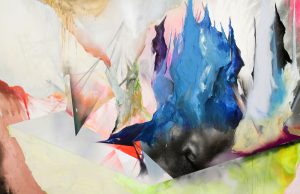
KINGDOM OF THE DISPOSSESSED
Kingdom of the Dispossessed is a work inspired by the dystopian novel ‘The Dispossessed’ by Ursula K. Le Guin, a tale set in the future amongst two inhabited twin worlds, the capitalist and decadent Urras, and Anarres, a planet of anarchism, minimalism, and equality. The character’s protagonist, Shevek, a brilliant physicist, leaves his native ‘anarchist’ world of Anarres to lend his knowledge and skills for space travel technology to the people of Urras. The story follows his lonely mission to try to connect to the vastly different societies and bring together the two worlds once more.
The artwork symbolizes the artist’s ‘in-limbo’ sensibility in the time of its creation based on her feeling’s of displacement in the realm between a life left in the United States and a new beginning in Europe: two ‘homes’ where she felt alien to in different ways. Yearning for a sense of belonging, a sensation only time could bring, Sadie created a fantasy of this unattainable place in the Kingdom of the Dispossessed.
SOKOL FERIZI writer
Sokol Ferizi b.1987 in Mitrovicë (Kosovo) is a writer, poet, and translator, living and working in Berlin. His work includes a book of poems, In a World Without Germany We Could Be So Good Together, and contributions to magazines such as Starship, Havenot, The Moth, and 212, as well as zines such as Lirindja, Kushtetuta, and Lamella. He is Contributing Editor and Staff Writer of Stillpoint Magazine.
SADIE WEIS artist
Sadie Weis is a trans-disciplinary artist and creator of work that combine alternating perceptions of reality and wonder with scientific elements. These creations simulate future-world-making and channels to fantastical sensations, through powerful constellations of inquiry and the imagination.
Sadie was born in Salina, Kansas, USA, and studied Painting and Fine Arts at the University of Kansas. She has had solo exhibitions in New York City and Berlin as well as a roster of international exhibitions. Sadie recently completed a research residency and grant program with scientists at Paul Drude Institut für Feskörperelektronik in Berlin exploring the relationships between art and the physical sciences.
KINGDOM OF THE DISPOSSESSED (2011): Oil, acrylic, wax medium, spray paint, ballpoint pen, permanent marker, tape on canvas. 160cm X 260cm.
© Copyright for all texts published in Stillpoint Magazine are held by the authors thereof, and for all visual artworks by the visual artists thereof, effective from the year of publication. Stillpoint Magazine holds copyright to all additional images, branding, design and supplementary texts across stillpointmag.org as well as in additional social media profiles, digital platforms and print materials. All rights reserved.
